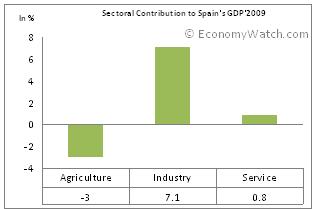Spain Economic Structure
Please note that we are not authorised to provide any investment advice. The content on this page is for information purposes only.
Spain’s economic structure is principally dominated by its service sector, which accounts for about 70% of its GDP. Spain’s tourism industry is the one of the largest in the world, next only to France and the US. The industry contributes nearly 11% to the nation’s GDP, and is responsible for employment of over 2 million individuals in the Spanish economy.[br]
Spain’s economic structure is principally dominated by its service sector, which accounts for about 70% of its GDP. Spain’s tourism industry is the one of the largest in the world, next only to France and the US. The industry contributes nearly 11% to the nation’s GDP, and is responsible for employment of over 2 million individuals in the Spanish economy.[br]
Spain Economic Structure: Overview
Spain stands at the thirteenth position in terms of GDP (PPP), which was $1.368 trillion in 2009, according to CIA reports. The service sector of the nation was responsible for the lion’s share of this amount, accounting for 69.6% of the total GDP and 71.7% of the total employment in Spain.
After the service sector, Spain’s industry sectors have been the second largest contributor to the economy, employing about a quarter of the nation’s total labor force of 22.97 million. The industry sector, which comprises of textiles, chemicals, shipbuilding, automobiles, metals and machine tools, is also responsible for a majority of the exports. Despite the fact that Spain is on the fast-track to modernization, the growth of the industry sector has been slow. According to CIA reports, Spain’s industrial production growth rate in 2009 was a dismal -15.8%.
The agricultural sector has been lagging substantially. This is primarily because of the unfavorable terrain and climate of the country, which makes more than half of the land uncultivable. In addition, the Spanish government’s conscious efforts to shift to a modernized economy, has diluted the importance of the agricultural sector, which employs a meager 4.2% of Spain’s total labor force. Despite this, Spain continues to be Europe’s biggest cultivator of oranges, strawberries and lemon and the world’s largest producer of olive oil.
The contribution by different sectors to Spain’s economic structure is as follows:

Spain Economic Structure and Monetary Policy[br]
The Central Bank of Spain follows a monetary policy that is independent of the national government, since the early 1990s. In fact, such a monetary policy is also pursued by several other western European states. However, since Spain is a member of the Economic and Monetary Union (EMU), the exchange rates of the nation are determined by the European Central Bank (ECB).




